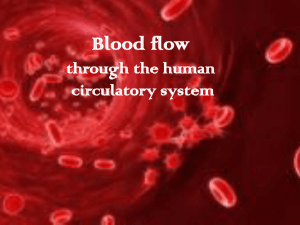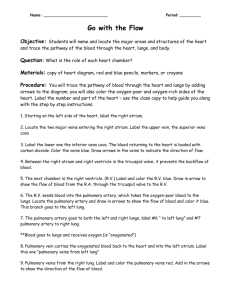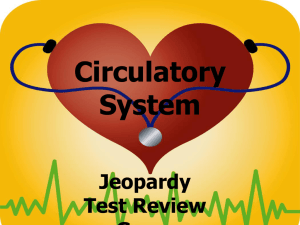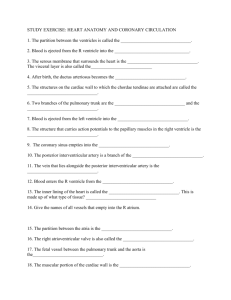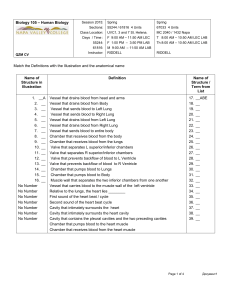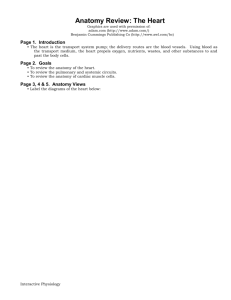Vocabulary
advertisement
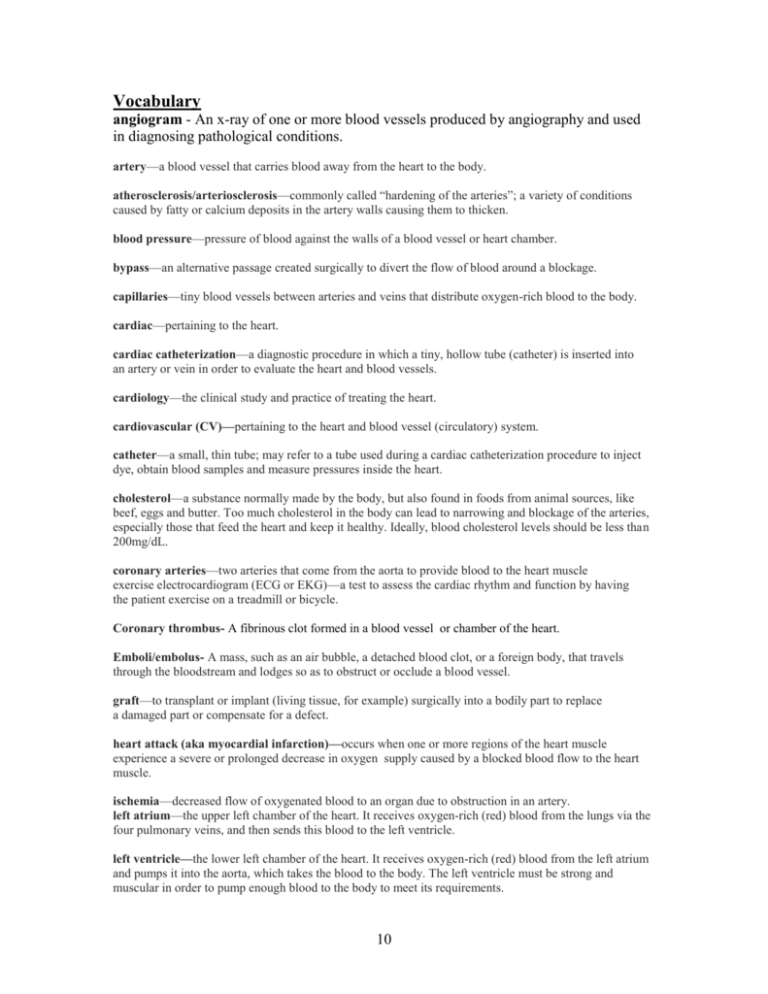
Vocabulary angiogram - An x-ray of one or more blood vessels produced by angiography and used in diagnosing pathological conditions. artery—a blood vessel that carries blood away from the heart to the body. atherosclerosis/arteriosclerosis—commonly called “hardening of the arteries”; a variety of conditions caused by fatty or calcium deposits in the artery walls causing them to thicken. blood pressure—pressure of blood against the walls of a blood vessel or heart chamber. bypass—an alternative passage created surgically to divert the flow of blood around a blockage. capillaries—tiny blood vessels between arteries and veins that distribute oxygen-rich blood to the body. cardiac—pertaining to the heart. cardiac catheterization—a diagnostic procedure in which a tiny, hollow tube (catheter) is inserted into an artery or vein in order to evaluate the heart and blood vessels. cardiology—the clinical study and practice of treating the heart. cardiovascular (CV)—pertaining to the heart and blood vessel (circulatory) system. catheter—a small, thin tube; may refer to a tube used during a cardiac catheterization procedure to inject dye, obtain blood samples and measure pressures inside the heart. cholesterol—a substance normally made by the body, but also found in foods from animal sources, like beef, eggs and butter. Too much cholesterol in the body can lead to narrowing and blockage of the arteries, especially those that feed the heart and keep it healthy. Ideally, blood cholesterol levels should be less than 200mg/dL. coronary arteries—two arteries that come from the aorta to provide blood to the heart muscle exercise electrocardiogram (ECG or EKG)—a test to assess the cardiac rhythm and function by having the patient exercise on a treadmill or bicycle. Coronary thrombus- A fibrinous clot formed in a blood vessel or chamber of the heart. Emboli/embolus- A mass, such as an air bubble, a detached blood clot, or a foreign body, that travels through the bloodstream and lodges so as to obstruct or occlude a blood vessel. graft—to transplant or implant (living tissue, for example) surgically into a bodily part to replace a damaged part or compensate for a defect. heart attack (aka myocardial infarction)—occurs when one or more regions of the heart muscle experience a severe or prolonged decrease in oxygen supply caused by a blocked blood flow to the heart muscle. ischemia—decreased flow of oxygenated blood to an organ due to obstruction in an artery. left atrium—the upper left chamber of the heart. It receives oxygen-rich (red) blood from the lungs via the four pulmonary veins, and then sends this blood to the left ventricle. left ventricle—the lower left chamber of the heart. It receives oxygen-rich (red) blood from the left atrium and pumps it into the aorta, which takes the blood to the body. The left ventricle must be strong and muscular in order to pump enough blood to the body to meet its requirements. 10 lipid—a fatty substance in the blood. open heart surgery—surgery that involves opening the chest and heart while a heart-lung machine performs for the heart and lungs during the operation. plaque—deposits of fat or other substances attached to the artery wall. a component of blood found in the plasma of mammals, functions to promote blood clotting. Also called blood platelet, thrombocyte. platelet- pulmonary—pertaining to the lungs and respiratory system. pulmonary artery—the blood vessel connecting the right ventricle to the lungs, allowing oxygen-poor (blue) blood to receive oxygen. pulmonary vein—the vessel that carries oxygenated blood from the lungs to the left side of the heart. right atrium—the upper right chamber of the heart, which receives oxygen-poor (blue) blood from the body and sends it to the right ventricle. right ventricle—the lower right chamber of the heart, which receives oxygen-poor (blue) blood from the right atrium and sends it to the pulmonary artery. risk factor—a condition, element or activity that may adversely affect the heart. saturated fat—fat that is found in foods from animal meats and skin, dairy products and some vegetables. (Saturated fats are usually solid at room temperature). stroke- a blockage or rupture of a blood vessel to the brain, can cause a sudden loss of brain function characterized by loss of muscular control, diminution or loss of sensation or consciousness, dizziness, slurred speech, or other symptoms that vary with the extent and severity of the damage to the brain. thrombus- A fibrinous clot formed in a blood vessel. vein—a blood vessel that carries blood from the body back to the heart. 11


